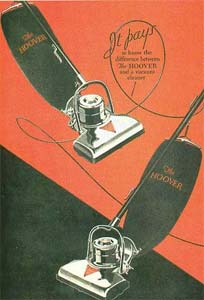
Vacuum Cleaners
Sweep Your Troubles Away...
Are Vacuum Cleaners Collectible?
Anything is collectible. We mean anything -- here's a guy who collects Airline Barf Bags.
If you want to collect vacuum cleaners, the following links will direct you to topics discussed on this page:
- Electrolux Model XXX
- Attachments for the Electrolux Model XXX
- Wagner Sweeper
- Hoover Model 541
- Elgin Jet Vac
- Super Chief Jet Vac
- Atlas "Cadillac" Vacuum
- Vintage Vacuum Ads
In addition to sweeper stuff, we have a Calendar of Swing Dancing in DC, a Directory of Vintage Clothing Stores and a Guide to 1940s Collectibles. Thanks for tuning in! Feel free to Contact Me if you have questions or want to share photographs and/or put on your "Soot Suit" and share stories with other sweeper lovers.
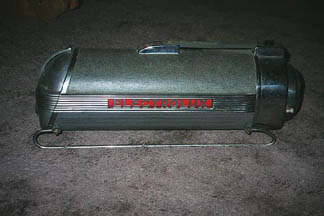
Electrolux Model 30 Vacuum Cleaner
Model XXX
Click to Enlarge
As you know by now, I am very fond of the 1930s - 1940s practice of streamlining inanimate objects. The Electrolux Model XXX is a fine example of this. It gets its lines from the fanciful space craft or pioneering streamlined trains, as interpreted by Lurelle Guild.
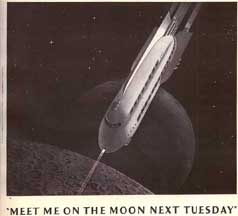

Dynamic Streamlined Objects of Public Fancy
The S-1 was designed by Raymond Loewy
Read more about this engine in our Streamlined Locomotives Page
Click to Enlarge
Lurelle Van Arsdale Guild (1898-1951) was one of the most prolific industrial designers of the 1930s. He studied painting at Syracuse Univerity and began his career doing covers for architectural and decorating magazines. He began work in industrial design in 1927 and became enormously successful, executing more than 1,000 patentable designs in one year. His primary work in the early years was for small item manufactureres such as Kensington or Chase Art metal. His skill lay in his ability to interpret popular themes in his designs. In 1937, he was awarded the contract to design the Model XXX vacuum cleaner for Electrolux, his most significant accomplishment. He also designed refrigerators for Norge, cookware for Wear-Ever and washing machines for General Electric. Guild lived in Darien Connecticut in a colonial-era home that he had moved from New Hampshire. His offices were at 545 Fifth Avenue, NYC. He was so well-known that his name and photograph were used to promote products, as shown below.
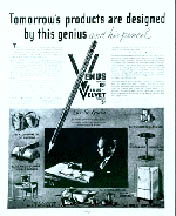
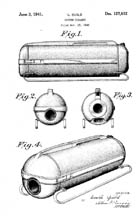

Lurelle Guild and his Model XXX Design Patents D-111,512 and 127,612
Even his pencils were famous...
Click here if you want to learn how to get Free Patent Drawings
The Electrolux Model XXX is made of the highest quality materials. The front and rear parts are heavy aluminum castings. The top part is actually covered in gray leather. It still runs like a champ and we have its complete attachment set, including: cord, hose, 2 wands, a rug cleaner, a floor brush, a dusting brush, an upholstery cleaner and a "narrow space cleaner".
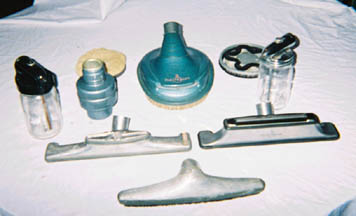
Electrolux Model 30 Attachments
Click to Enlarge 4th (back) Row: Buffer Pad, Floor Polisher, Polisher Brushes
3rd Row: Wax Sprayer, Atomizer, Moth Sprayer
2nd Row: bare Floor Sweeper, Carpet Tool
Front: Upholstery and Drapery Tool
The machine can be configured to expel (blow out) air as well as impel (suck in). For extra money, you could buy a number of air-powered devices such as a tire inflator, a paint sprayer or a crop sprayer. To tell the truth, I have never seen an Electrolux in the garden.... The "Expel" tools that I own are the Floor polisher, the Wax Sprayer, the Atomizer, and the Moth Sprayer. The floor polisher uses the current of air to turn a tubine. The atomizer blows the air through a moistened sponge. The sprayers work just like their contemporary counterparts.
My favorite is the Floor Polisher which has wonderfully streamlined curves that reminds me of a flying saucer. This, too was designed by Lurelle Guild, although the mechanism inside was designed by Emil Anderson. Of note, the Exterior was patented on May 30, 1950 while the mechanical design was patented on September 9, 1952
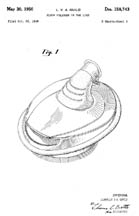

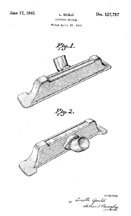
The Floor Polisher for the Electrolux Model XXX
Lurelle Guild Design Patent D-158,743 for the Floor Polisher Exterior
Mr. Anderson received Patent 2,609,555 on September 9, 1952 for "...an apparatus for polishing, scrubbing and variously otherwise treating surfaces..."
Mr. Guild's Intake Tool Patent D-127,797
Click here if you want to learn how to get Free Patent Drawings
The intake tools are interesting -- they can be "Flipped" to expose a much smaller intake area, and hence augment the suction force. The bare floor sweeper has a small opening on the top that is very effective in picking up piles of dirt or dust, such as might result from spilled sugar or a broken houseplant. The valve mechanism for shutting one opening and opening another is very intriguing. Clearly, a lot of very ingenious design work went into this system.
This is a true domestic icon. In addition to fantastic lines, it is a mechanical marvel. They literally don't make them like this any more...
As time marched forward, the Electrolux folks turned to Norman Bel Geddes for a design update. The result was the Model LX. This was a very serviceable and useful vacuum cleaner, but really lacks the cachet of the Model XXX. It is my guess that Bel Geddes took his inspiration from the art deco PCC Streetcar design.

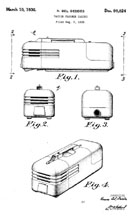
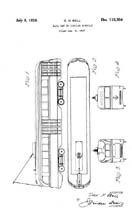
The Electrolux Model LX
Norman Bel Geddes Patent D-158,743
PCC Streetcar Design Patent D-110,384
Click here if you want to learn how to get Free Patent Drawings
After the Model LX, Electrolux started making the vacuums largely out of plastic. My interest wanes at that point.
Click here to look at another type of collectible, or keep on scrolling to see more vacuum cleaners.

Wagner Sweepers
Click to Enlarge
This is a carpet cleaner, but it does not employ suction to collect dirt, and is thus called a sweeper. This type of cleaner can be very useful for small spills and quick touch-up jobs. It is handy because it doesn't have to be plugged in. The device uses gearing to drive a rotary brush as the sweeper is pushed along. Dirt is swept into a chamber at the rear which can be emptied into a trash can. Bissel is the largest manufacturers of carpet sweepers. This model, from the Wagner company is somewhat rarer, as that company has evolved and is now known for making hinges and casters.
The Wagner company presents an interesting picture of corporate growth and change. On December 28, 1899, E.R. Wagner paid $11,000 for the purchase of the Baby Carriage Hardware Department of The American Bicycle Co. The E.R. Wagner Mfg. Co. began business at the dawn of the new century. By 1912, the company had diversified from baby carriages to "go-carts" or sulkies -- small chariot-like vehicles that could be hitched to a horse or pony. 1912, the Wagner Folding Go-Cart was advertised as the “most comfortable and complete of Go-Carts”. Pictured here is the top of the line model which sold for $11.50, though you could buy a Go-Cart for as little as $4.00.
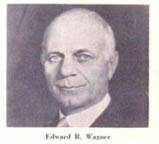
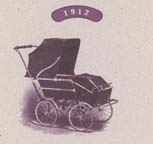

E.R. Wagner, Baby carriages, and Go-Carts
Click to Enlarge
In 1924 the company purchased the assets of Milwaukee Shock Absorber Co. and started making friction type shock absorbers for Model T Fords. They were tested by driving back and forth over the railroad ties west of the plant. In 1931, E.R. Wagner purchased the National Clinch Hinge Co. and made history. The company began manufacturing hinges in all sizes for everything from jewelry boxes to airplanes. The line includes continuous hinges, and today E.R. Wagner is the largest automotive hinge manufacturer in the U.S. Suring World War II, the company devoted itself to subcontracting work, manufacturing wheels for conveyors used to unload airplanes, hardware for army cots and a variety of hinges for everything from munition boxes to tanks. The Wagner Wheel pictured here would later be used on roller skates and skateboards as well as conveyors.
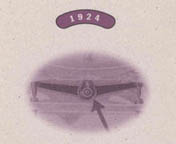
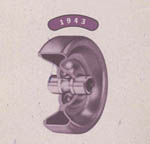
Wagner Shock Absorbers and The Wagner Wheel
Click to Enlarge
The Wagner company began manufacturing carpet sweepers in 1932. Here is the design patent for one of their early models.
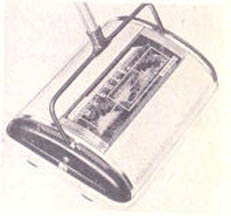
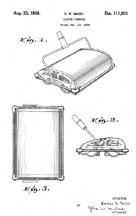
The Wagner Sweeper
Design Patent D-111,033 Click to Enlarge
Currently, the Wagner company is most known for making casters.
Click here to look at another type of collectible, or keep on scrolling to see more vacuum cleaners.
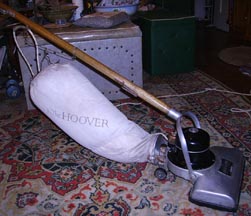
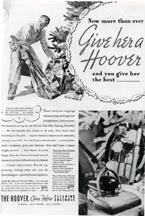
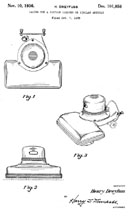
The Hoover Model 541
Henry Dreyfuss Design Patent D-101,858 for this model
Click to Enlarge
The Hoover Model 541 was introduced in 1923. It replaced the model 105 from 1919. It uses a very simple motor, which was quiet but slow-running. The motor runs a brush-roll, even though the product was sold under the famous "it beats as it sweeps as it cleans" slogan, which wrongly suggested it used a beater.
The chassis was apparently made of aluminium, which means that it is lightweight. It is also a comparatively soft material, so it would be easy to manufacture, although it was most probably an aluminium alloy so that it would not just bend when being manufactured. If so, it would be copper or zinc that were added to the raw aluminium. The shell of the motor, presumably made of the same material, was painted in a black enamel finish. The handle was a solid piece of softwood. This would mean that it would be cheap and quick to produce, and light as well. It would also be cheap to replace. The bearings in the motor were made of brass, a copper and zinc alloy, and required regular greasing. They were probably made of brass because it is easy to machine, and also easy to weld. It is very dense too, which makes it ideal for engine parts which need to be heavy.
To give you an idea of the mass-production of these things, here is a photo of an assembly line, as described by our reader Richard:
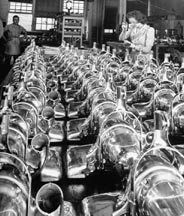
The Vacuum Cleaner Assembly Line
Click to Enlarge
"... [they are making] Hamilton Beach No. 14, also called the Champion. This dates the photo at around 1937. The tapered motor, polished finish, and the tell-tale toe-pedal height adjustment (with the black button) give it away ..."
There are no real technological advances here in the way the vacuum cleaner actually works, but it was the first from Hoover that had a cast aluminum chassis. People wanted their home vacuum cleaners to be as light as possible, and this was definitely a step in the right direction. Hoover's first vacuum cleaner, the Hoover O, weighed 40 pounds made from wood and tin, so the new lightweight aluminium Model 541 would have been a welcome purchase in many homes. It would also probably be more affordable to customers, as by 1923 vacuum cleaners were fairly common. During World War II, the Model 541 made its way into a training pamphlet. The subject was "How to use electrical appliances." Many rural households were just getting electricity due to the Rural Electrification Administration (REA) and the pamphlet was intended to get folks up to speed with the rest of the country. These photos show the proper technique for vacuuming loose rugs and how to empty the bag.
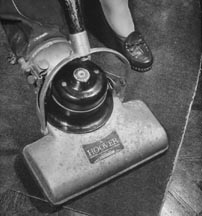
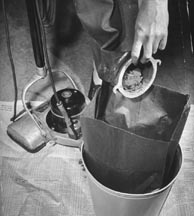
Government Approved Use of the Hoover Model 541
Click to Enlarge
This will give you an idea of the competition for the Hoover 541 -- this is the "Wardway" economy model offered by Montgomery Wards. The vacuum sold for $29.95, but could be had in monthly installments of $5.00 ("6 easy payments" in the language of today's infomercials...) It is of some note that the Wards model was offered in a DC version. As noted in our Energy Page, many farms used wind or combustion engines to generate DC power.
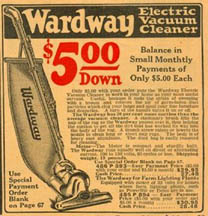
Ad for the 1932 Wardway Sweeper
Click to Enlarge
Here is a Collectors Website that will give you a LOT more information about the Hoover Model 541. Here is a video of the Model 541 in action.
The Hoover company was very forward-thinking and used the services of renowned industrial designers. Raymond Loewy did the famous corporate logo, and Henry Dreyfuss did a lot of imaginative designs for cleaners. His 1936 design exploration was picked up by Hoover for manufacture in the United Kingdom as the Hoover Model 825. This proved to be one of the most popular vacuum cleaners in England and this model is definitely collectible.

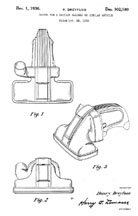

The Model 825 also bears a striking resemblance to the Kirby Model 2C
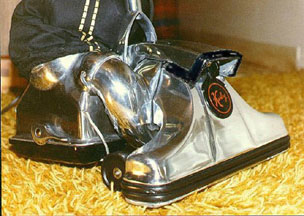
Industrial Design in the Vacuum World
Hoover Logo by Raymond Loewy
Henry Dreyfuss Design Patent D-102,180
Hoover Model 825
Kirby Model 2C
Click to Enlarge
However, Hoover had a major hit on other Henry Dreyfuss designs, including the Model 825 and the ultra-streamlined Model 160. Note that each step of "streamlining" hides the essential nature of the functional parts of the machine. In the Model 541, it is very clear which part is the motor, the intake, etc. By the Model 160, the machine looks like a vehicle with a mini-engineer driving the thing from the headlight compartment.
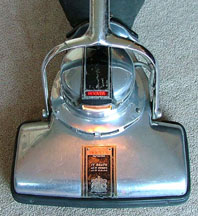
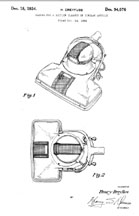
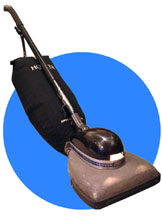

Henry Dreyfuss' Greatest Hits
Hoover Model 825
Henry Dreyfuss Design Patent D-94,076 for the Model 825
Hoover Model 160
Henry Dreyfuss Design Patent D-118,618 for the Model 160
Click to Enlarge
Speaking of trains, Henry Dreyfuss designed a really marvelous hand vacuum that was never made by Hoover. As you can see below, he was probably thinking of his locomotive for the Twentieth Century Limited when he was designing the cleaner. However, something very close to this was manufactured by Westinghouse


Cross-Fertilization of Ideas
Dreyfus patent D-116,180 for the iconic NYC Hudson Locomotive
Dreyfuss Hoover Vacuum Cleaner Design Patent D-115,286

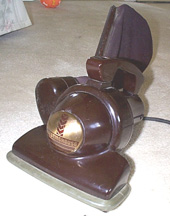
Westinghouse Hand Vacuum that has elements of the Dreyfuss design
Click to Enlarge
Click here to look at another type of collectible, or keep on scrolling to see more vacuum cleaners.

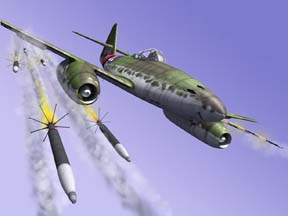
Elgin Jet Vac
Jets were the rage in the late 1940s
Click to Enlarge
This is an Elgin Cannister vacuum cleaner that dates from the late 1940s. Although it is fundamentally a stationary object, it is in the shape of a jet engine, following the concept that utilitarian objects tend to mirror the frontiers of technology. (Well, I guess you drag it from place to place as you vacuum, but I really don't think air resistance is a factor when you are moving at the speed of housekeeping.) Compare this with the Hoover Model XXX pictured above, whose design inspiration came from streamlined railroad trains.
The Elgin has a superb metal flake finish, something that would be an inspiration to George Barris. We have restored it to full function, but it mainly serves as an art object because I don't want to take a chance on damaging the finish by using it. It sits in front of our fireplace like a faithful dog.
Compare the Elgin Jet Vacuum with a cheaper knockoff called the "Super Chief".
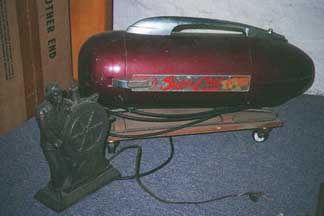
Super Chief Vacuum Cleaner
Named after a Train, Shaped Like a Jet Engine
Click to Enlarge
This stylish cannister vacuum is the Universal "Atlas" model.

The Atlas "Cadillac" Vacuum
Made by Landers, Frary and Clark
The distinctive gold chevron (or "V") is similar to the General Motors trademark for the Cadillac automobile. Hence, this is also called the "Cadillac". The "Universal" line of appliances was made by Landers, Frary and Clark of Connecticut.
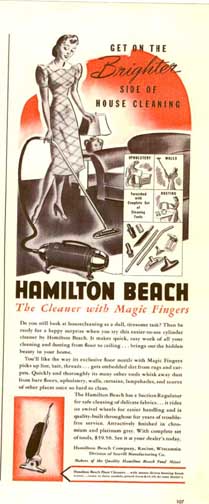
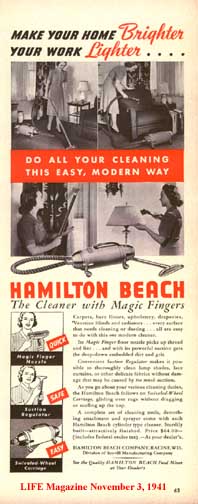
Hamilton-Beach Canister Vacuum
1941 Ads From LIFE Magazine, (l.) March 24 (r.) November 3
This is an ad for the Hamilton-Beach canister vacuum cleaner. This does most of the same things as the Electrolux. You will note that the price for the cleaner is $59.50 in March (left) while it has risen to $64.00 By November. [$64 in 1941 dollars -- is the same as $1,280 in 2005!] This was a very very big luxury. For that kind of dough, it had better make your life brighter and your work lighter!
Over at Hoover, they weren't taking any chances - they had discounted their model to $48.50. This version of the Hoover was designed by Henry Dreyfuss and this fact is mentioned in Point 8 of the ad. However, in order to get the $48.50 price, you had to trade in your old vacuum cleaner.
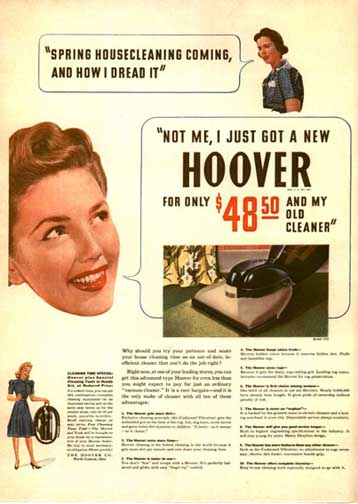
Hoover Upright and Canister Vacuum Cleaners
From LIFE Magazine, March 24, 1941
In 1947, Hoover ran a two page spread in LIFE magazine extolling the virtues of BOTH their upright and canister vacuum cleaners.
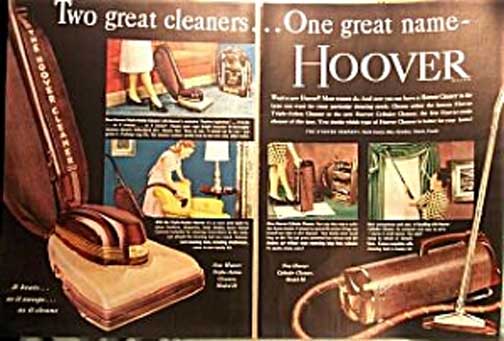
Hoover Upright and Canister Vacuum Cleaners
From LIFE Magazine, 1947
Click here to look at another type of collectible, or keep on scrolling for more vacuum cleaners.
Counter for the Entire Site (not just this page..)
Home | About Lindy | Last Week's Reviews | Upcoming Events | 1940s Collectibles
The Guide - Establishments - Travel - Accessories
Music | Links | Photo Gallery | Extras | Contact